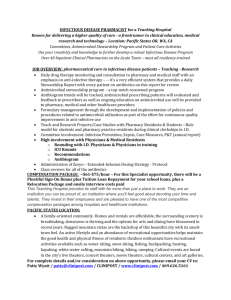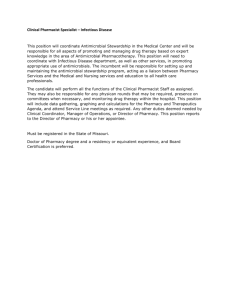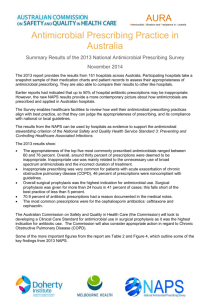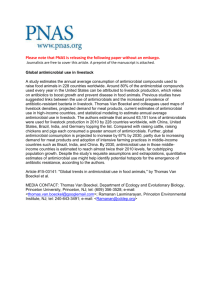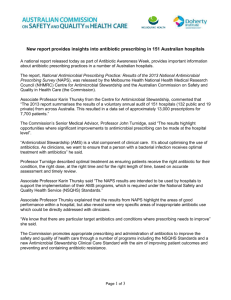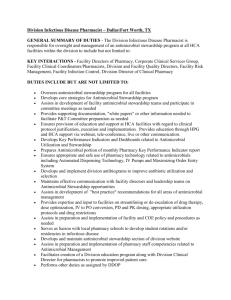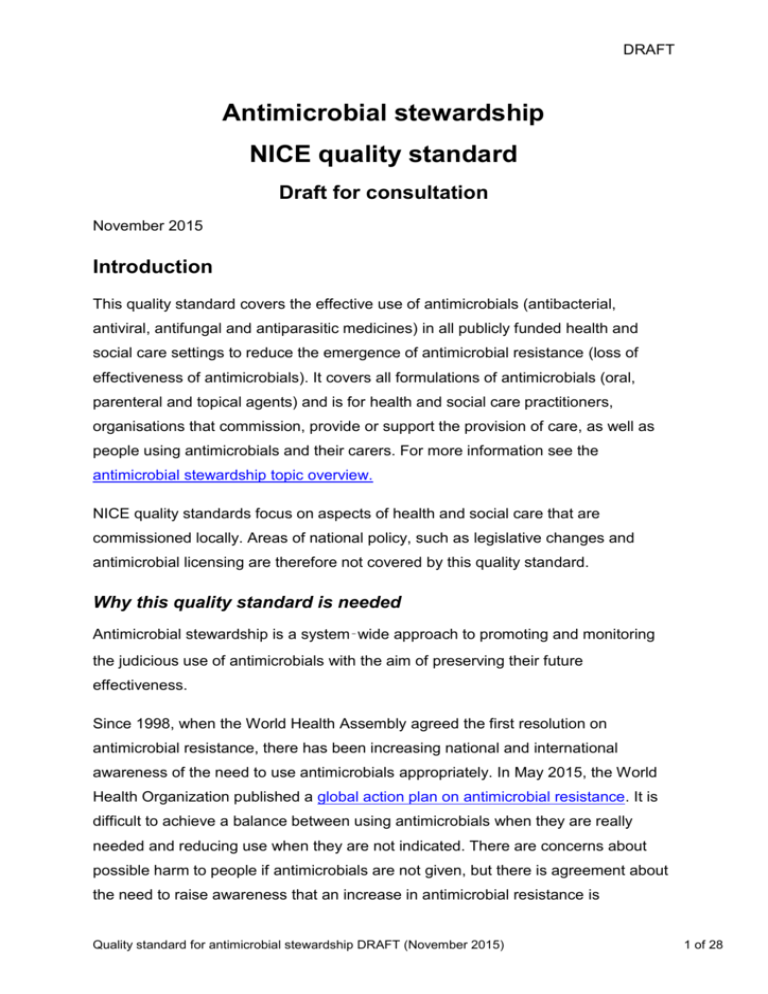
DRAFT
Antimicrobial stewardship
NICE quality standard
Draft for consultation
November 2015
Introduction
This quality standard covers the effective use of antimicrobials (antibacterial,
antiviral, antifungal and antiparasitic medicines) in all publicly funded health and
social care settings to reduce the emergence of antimicrobial resistance (loss of
effectiveness of antimicrobials). It covers all formulations of antimicrobials (oral,
parenteral and topical agents) and is for health and social care practitioners,
organisations that commission, provide or support the provision of care, as well as
people using antimicrobials and their carers. For more information see the
antimicrobial stewardship topic overview.
NICE quality standards focus on aspects of health and social care that are
commissioned locally. Areas of national policy, such as legislative changes and
antimicrobial licensing are therefore not covered by this quality standard.
Why this quality standard is needed
Antimicrobial stewardship is a system‑wide approach to promoting and monitoring
the judicious use of antimicrobials with the aim of preserving their future
effectiveness.
Since 1998, when the World Health Assembly agreed the first resolution on
antimicrobial resistance, there has been increasing national and international
awareness of the need to use antimicrobials appropriately. In May 2015, the World
Health Organization published a global action plan on antimicrobial resistance. It is
difficult to achieve a balance between using antimicrobials when they are really
needed and reducing use when they are not indicated. There are concerns about
possible harm to people if antimicrobials are not given, but there is agreement about
the need to raise awareness that an increase in antimicrobial resistance is
Quality standard for antimicrobial stewardship DRAFT (November 2015)
1 of 28
DRAFT
associated with antimicrobial prescribing. Antimicrobial stewardship requires a
system-wide approach with individuals and organisations working together to
preserve the effectiveness of antimicrobials.
In 2014, the English surveillance programme for antimicrobial utilisation and
resistance (ESPAUR) published a report reviewing prescribing patterns for
antimicrobials in different care settings between 2010 and 2013. This showed that:
combined community and hospital prescriptions increased by 6%
general practice consumption increased by 4.1%
prescribing to hospital inpatients increased year-on-year by an average of 3.5%,
with a total increase of 11.9%
prescribing to hospital outpatients remained stable
’other community prescribing’ increased by 32%.
Primary care antibiotic prescribing has been shown to directly affect antimicrobial
resistance1.
Between 2010 and 2013 most antimicrobial prescribing occurred in general practice.
In 2013, 78.5% of prescribing was in general practice, with 9.1% and 6.2% for
hospital inpatients and outpatients respectively, and 6.2% related to other community
prescribers (predominantly dentists).
The quality standard is expected to contribute to improvements in the following
outcomes:
antimicrobial prescribing rates
antimicrobial resistance.
How this quality standard supports delivery of outcome
frameworks
NICE quality standards are a concise set of prioritised statements designed to drive
measurable improvements in the 3 dimensions of quality – patient safety, patient
experience and clinical effectiveness – for a particular area of health or care. They
1
C. Costelloe et al.(2010) Effect of antibiotic prescribing in primary care on antimicrobial resistance in
individual patients: systematic review and meta-analysis
Quality standard for antimicrobial stewardship DRAFT (November 2015)
2 of 28
DRAFT
are derived from high-quality guidance, such as that from NICE or other sources
accredited by NICE. This quality standard, in conjunction with the guidance on which
it is based, should contribute to the improvements outlined in the following
2 outcomes frameworks published by the Department of Health:
NHS Outcomes Framework 2015–16
Public Health Outcomes Framework 2013–16.
Tables 1 and 2 show the outcomes, overarching indicators and improvement areas
from the frameworks that the quality standard could contribute to achieving.
Table 1 NHS Outcomes Framework 2015–16
Domain
5 Treating and caring for
people in a safe environment
and protecting them from
avoidable harm
Overarching indicators and improvement areas
Overarching indicators
5a Deaths attributable to problems in healthcare
5b Severe harm attributable to problems in healthcare
Improvement areas
Reducing the incidence of avoidable harm
5.2 Incidence of healthcare associated infection (HCAI)
i MRSA
ii C. difficile
Improving the culture of safety reporting
5.6 Patient safety incidents reported
Table 2 Public health outcomes framework for England, 2013–16
Domain
3 Health protection
Objectives and indicators
Objective
The population’s health is protected from major incidents
and other threats, whilst reducing health inequalities
Indicators
3.5 Treatment completion for TB
3.7 Comprehensive, agreed inter-agency plans for
responding to public health incidents and emergencies
Patient experience and safety issues
Ensuring that care is safe and that people have a positive experience of care is vital
in a high-quality service. It is important to consider these factors when planning and
delivering antimicrobial stewardship across healthcare settings.
Quality standard for antimicrobial stewardship DRAFT (November 2015)
3 of 28
DRAFT
NICE has developed guidance and an associated quality standard on patient
experience in adult NHS services (see the NICE pathway on patient experience in
adult NHS services), which should be considered alongside this quality standard.
They specify that people receiving care should be treated with dignity, have
opportunities to discuss their preferences, and be supported to understand their
options and make fully informed decisions. They also cover the provision of
information to patients and service users. Quality statements on these aspects of
patient experience are not usually included in topic-specific quality standards.
However, recommendations in the development sources for quality standards that
affect patient experience and are specific to the topic are considered during quality
statement development.
Coordinated services
A whole system, integrated approach to antimicrobial stewardship is fundamental to
preserving the effectiveness of antimicrobial medicines.
The Health and Social Care Act 2012 sets out a clear expectation that the care
system should consider NICE quality standards in planning and delivering services,
as part of a general duty to secure continuous improvement in quality.
Commissioners and providers of health and social care should refer to the library of
NICE quality standards when designing high-quality services.
This quality standard is very closely related to other quality standards and should be
read alongside QS49 on surgical site infection, QS61 on infection prevention and
control, QS75 on antibiotics for neonatal infection and currently developed quality
standard on healthcare-associated infections. Other quality standards that should
also be considered when promoting and monitoring the judicious use of
antimicrobials are listed in related quality standards. [Link to section in web version]
Training and competencies
The quality standard should be read in the context of national and local guidelines on
training and competencies. All prescribers of antimicrobials should have sufficient
and appropriate training and competencies to deliver the actions and interventions
described in the quality standard. Quality statements on staff training and
competency are not usually included in quality standards. However,
Quality standard for antimicrobial stewardship DRAFT (November 2015)
4 of 28
DRAFT
recommendations in the development sources on specific types of training for the
topic that exceed standard professional training are considered during quality
statement development.
Role of families and carers
Quality standards recognise the important role families and carers have in supporting
people using antimicrobials. If appropriate, healthcare professionals and social care
practitioners should ensure that family members and carers are given advice on the
judicious use of antimicrobials and the adverse consequences of overusing them.
List of quality statements
Statement 1. People presenting to primary care prescribers with self-limiting
conditions receive advice about self-management and why antimicrobials are not
recommended for the treatment of their condition.
Statement 2. People presenting in primary care are informed about the option of
back-up (delayed) prescribing if there is uncertainty about whether their condition is
self-limiting.
Statement 3 People prescribed an antimicrobial have the clinical indication, dose and
duration of treatment documented in their clinical record.
Statement 4 People in hospital prescribed an antimicrobial have a microbiological
sample taken and their treatment reviewed when the results are available.
Statement 5 Antimicrobial stewardship teams or individuals responsible for
antimicrobial stewardship collect data and provide feedback on prescribing practice
at individual, team and organisational level.
Statement 6 (developmental statement): Prescribers in secondary care and dental
practices use electronic prescribing systems.
Quality standard for antimicrobial stewardship DRAFT (November 2015)
5 of 28
DRAFT
Questions for consultation
Questions about the quality standard
Question 1 Does this draft quality standard accurately reflect the key areas for
quality improvement?
Question 2 If the systems and structures were available, do you think it would be
possible to collect the data for the proposed quality measures?
Question 3 Do you have an example from practice of implementing the NICE
guidelines that underpin this quality standard? If so, please submit your example to
the NICE local practice collection on the NICE website. Examples of using NICE
quality standards can also be submitted.
Questions about the individual quality statements
Question 4 For draft developmental statement 6: Does this reflect an emergent area
of service delivery or technology? If so, does this indicate outstanding performance
only carried out by a minority of providers that will need specific, significant changes
to be put in place, such as redesign of services or new equipment? Can you provide
any examples of current practice in this area?
Quality standard for antimicrobial stewardship DRAFT (November 2015)
6 of 28
DRAFT
Quality statement 1: Advice for self-limiting conditions
Quality statement
People presenting to primary care prescribers with self-limiting conditions receive
advice about self-management and why antimicrobials are not recommended for the
treatment of their condition.
Rationale
Some people with a self-limiting condition, such as cold, flu, cough, ear or toothache,
may expect to be prescribed an antimicrobial and may not know that their condition
is likely to get better without treatment. Primary care prescribers should manage
these expectations by describing the adverse consequences of using antimicrobials
when they are not needed, both for the person and the population as a whole.
Prescribers should also give advice on what the person can do to help their condition
improve (self-care).
Quality measures
Structure
Evidence of local arrangements to ensure that people with self-limiting conditions
receive advice about how to manage their condition and the adverse consequences
of overusing antimicrobials.
Data source: Local data collection.
Process
a) Proportion of people with a self-limiting condition who receive advice about how
to manage their condition.
Numerator – the number in the denominator who receive advice about how to
manage their condition.
Denominator – the number of people with a self-limiting condition presenting in
primary care.
Data source: Local data collection
Quality standard for antimicrobial stewardship DRAFT (November 2015)
7 of 28
DRAFT
b) Proportion of people with a self-limiting condition who receive advice about the
adverse consequences of overusing antimicrobials.
Numerator – the number in the denominator who receive advice about the adverse
consequences of overusing antimicrobials.
Denominator – the number of people with a self-limiting condition presenting in
primary care.
Data source: Local data collection
What the quality statement means for service providers, healthcare
professionals, and commissioners
Service providers (GP practices, health centres, dental practices, pharmacies,
podiatry services,) ensure that systems are in place for people presenting with selflimiting conditions to receive advice about how to manage their condition and the
adverse consequences of overusing antimicrobials.
Prescribers in primary care (GPs, nurses, dentists, pharmacists, podiatrists)
ensure that they provide people with self-limiting conditions with advice on how to
manage their condition and the adverse consequences of overusing antimicrobials.
Commissioners (clinical commissioning groups, NHS England) ensure that they
commission services that provide people with self-limiting conditions with advice on
how to manage their condition and the adverse consequences of overusing
antimicrobials.
What the quality statement means for patients, service users and
carers
People who go to ae healthcare professionals with a condition that is likely to get
better on its own (such as cold, flu, cough, tooth or earache) are given advice on
what they can do to help their condition improve and why it’s important only to use
antimicrobials when they are really needed.
Source guidance
Antimicrobial stewardship (2015) NICE guideline NG15, recommendation 1.1.31
Quality standard for antimicrobial stewardship DRAFT (November 2015)
8 of 28
DRAFT
Antimicrobial stewardship – changing risk related behaviours in the general
population (expected March 2016) draft recommendations 1.7.1 and 1.7.4
Definitions of terms used in this quality statement
Self-limiting conditions
Self-limiting conditions are conditions that are likely to resolve without antimicrobial
treatment. They include the common cold and acute respiratory tract infections such
as otitis media, cough, bronchitis, sore throat, pharyngitis, tonsillitis, and
rhinosinusitis.
[Respiratory tract infections (self-limiting): prescribing antibiotics (2008) NICE
guideline CG69 (full guideline) and expert opinion]
Advice for people with self-limiting conditions
Prescribers should discuss with the person and/or their family members or carers (as
appropriate):
the likely nature of the condition
why prescribing an antimicrobial may not be the best option
alternative options to prescribing an antimicrobial
their views on antimicrobials, taking into account their priorities or concerns about
their current illness and whether they want or expect an antimicrobial
the benefits and harms of immediate antimicrobial prescribing
what they should do if their condition gets worse (safety netting advice) or if they
have problems as a result of treatment
whether they need any written information about their medicines and any possible
outcomes.
[Antimicrobial stewardship (2015) NICE guideline NG15, recommendation 1.1.31]
Equality and diversity considerations
Healthcare professionals may need to consider how to advise people who have
difficulties understanding the information given to them because of difficulty in
understanding English or cognitive impairment.
Quality standard for antimicrobial stewardship DRAFT (November 2015)
9 of 28
DRAFT
Quality statement 2: Back-up (delayed) prescribing
Quality statement
People presenting in primary care are informed about the option of back-up
(delayed) prescribing if there is uncertainty about whether their condition is selflimiting.
Rationale
When there is clinical uncertainty about whether a condition is self-limiting, back–up
(delayed) prescribing gives healthcare professionals an alternative to immediate
antimicrobial prescribing. It allows the person to self-manage as a first step, but also
to have easy access to antimicrobials if their condition gets worse.
Quality measures
Structure
a) Evidence of local arrangements to ensure that back-up (delayed) prescribing is a
decision support system that prescribers can use if there is uncertainty about the
self-limiting nature of the condition.
Data source: Local data collection.
b) Evidence of local arrangements and processes to ensure that people presenting
in primary care are informed about the option of a back-up (delayed) prescribing if
there is uncertainty about whether their condition is self-limiting.
Data source: Local data collection.
Process
a) Proportion of people issued with a back-up (delayed) prescription for
antimicrobials who had been informed when to use the prescription.
Numerator – the number in the denominator who had been informed when to use the
prescription.
Quality standard for antimicrobial stewardship DRAFT (November 2015)
10 of 28
DRAFT
Denominator – the number of people issued with a back-up (delayed) prescription for
antimicrobials.
Data source: Local data collection.
b) Proportion of people collecting a back-up (delayed) prescription for antimicrobials.
Numerator – the number in the denominator who collected their back-up (delayed)
prescription for antimicrobials.
Denominator – the number of people issued with a back-up (delayed) prescription for
antimicrobials.
Data source: Local data collection.
What the quality statement means for service providers,
prescribers, and commissioners
Service providers (GP practices, health centres dental practices, pharmacies,
podiatry services) ensure that systems are in place for people to be informed about
the option of back-up (delayed) prescribing if there is uncertainty about whether their
condition is self-limiting.
Primary care prescribers (GPs, nurses, dentists, pharmacists, podiatrists) ensure
that they inform people about the option of back-up (delayed) prescribing if there is
uncertainty about whether their condition is self-limiting.
Commissioners (clinical commissioning groups, NHS England) ensure that the
services they commission inform people about the option of back-up (delayed)
prescribing if there is uncertainty about whether their condition is self-limiting.
What the quality statement means for patients, service users and
carers
People with conditions that may need antimicrobial treatment but may get better
without treatment, are informed by their healthcare professional about an option of
having a prescription for an antimicrobial that they use only if their condition doesn’t
Quality standard for antimicrobial stewardship DRAFT (November 2015)
11 of 28
DRAFT
improve. This is known as a back-up or delayed prescription. They are given clear
advice about when they should use the prescription.
Source guidance
Antimicrobial stewardship (2015) NICE guideline NG15, recommendation 1.1.34
Definitions of terms used in this quality statement
Back-up (delayed prescribing)
A back-up (delayed) prescription is a prescription (which can be post-dated) given to
a patient or carer, with the assumption that it will not be dispensed immediately, but
in a few days if symptoms worsen.
When using a back-up (delayed) antibiotic prescribing strategy, patients should be
offered:
reassurance that antibiotics are not needed immediately because they are likely to
make little difference to symptoms and may have side effects, for example,
diarrhoea, vomiting and rash
advice about using the back-up (delayed) prescription if symptoms are not starting
to settle as expected or if a significant worsening of symptoms occurs
advice about re-consulting if there is a significant worsening of symptoms despite
using the back-up (delayed) prescription.
A back-up (delayed) prescription with instructions about use can either be given to
the patient or left at an agreed location (for example, the local pharmacy) to be
collected at a later date.
[Respiratory tract infections (self-limiting): prescribing antibiotics (2008) NICE
guideline CG69 recommendation 1.1.6 and expert opinion]
Equality and diversity considerations
Prescribers may need to consider how to advise people who have difficulties in
understanding the information given to them because of difficulty in understanding
English or cognitive impairment.
Quality standard for antimicrobial stewardship DRAFT (November 2015)
12 of 28
DRAFT
Quality statement 3: Recording information
Quality statement
People prescribed an antimicrobial have the clinical indication, dose and duration of
treatment documented in their clinical record.
Rationale
Recording in patients’ records the clinical indication (that is, the results of clinical
assessment, symptoms and diagnosis) for an antimicrobial, and the prescribed dose
and duration of treatment, allows monitoring of prescribing practice and identification
of appropriate and inappropriate prescribing.
Quality measures
Structure
Evidence of local arrangements and processes to ensure that all prescribers
document the clinical indication, dose and duration of treatment in patients’ records
when prescribing an antimicrobial.
Data source: Local data collection.
Process
Proportion of antimicrobial prescriptions with a clinical indication, dose and duration
of treatment documented.
Numerator – the number in the denominator with the clinical indication, dose and
duration of treatment recorded.
Denominator – the number of antimicrobial prescriptions.
Data source: Local data collection.
What the quality statement means for service providers,
prescribers, and commissioners
Service providers (hospitals, walk-in centres, GP practices, health centres, dental
practices, pharmacies, podiatry services) ensure that systems are in place for all
Quality standard for antimicrobial stewardship DRAFT (November 2015)
13 of 28
DRAFT
prescribers to document in patients’ records the clinical indication, dose and duration
of treatment when an antimicrobial is prescribed.
Prescribers document in patients’ records the clinical indication, dose and duration
of treatment when they prescribe an antimicrobial.
Commissioners (clinical commissioning groups, NHS England) ensure that they
commission services that document in patients’ records the clinical indication, dose
and duration of treatment when an antimicrobial is prescribed.
What the quality statement means for patients, service users and
carers
People who are prescribed an antimicrobial have their symptoms and diagnosis
recorded in their medical record, as well as how long they should take the
antimicrobial and the dose.
Source guidance
Antimicrobial stewardship (2015) NICE guideline NG15, recommendations 1.1.26
and 1.1.32
Quality standard for antimicrobial stewardship DRAFT (November 2015)
14 of 28
DRAFT
Quality statement 4: Microbiological samples
Quality statement
People in hospital prescribed an antimicrobial have a microbiological sample taken
and their treatment reviewed when the results are available.
Rationale
Analysing microbiological samples allows more targeted and effective prescribing of
appropriate, potentially narrow-spectrum antimicrobials or stopping the antimicrobials
if test results indicate they are not necessary or ineffective. In hospital,
microbiological samples should be taken before antimicrobials are prescribed, but it
is sometimes necessary to start antimicrobial treatment before the microbiological
results are available.
Quality measures
Structure
Evidence of local arrangements and processes to ensure that people in hospital who
are prescribed an antimicrobial have a microbiological sample taken and their
treatment reviewed when the results are available
Data source: Local data collection.
Process
a) Proportion of hospital admissions with a record of microbiological sample being
taken at the time of prescribing an antimicrobial.
Numerator – the number in the denominator with a record of microbiological sample
being taken at the time of prescribing an antimicrobial.
Denominator – the number of hospital admissions with an antimicrobial prescription.
Data source: Local data collection.
b) Proportion of hospital admissions with the antimicrobial prescription reviewed
when the microbiological results become available.
Quality standard for antimicrobial stewardship DRAFT (November 2015)
15 of 28
DRAFT
Numerator – the number in the denominator with the antimicrobial prescription
reviewed when the microbiological results become available.
Denominator – the number of hospital admissions with a record of microbiological
sample being taken at the time of prescribing an antimicrobial.
Data source: Local data collection.
Data source: Local data collection.
What the quality statement means for service providers,
prescribers, and commissioners
Service providers (hospitals) ensure that systems are in place for people in hospital
to have a microbiological sample taken before they are prescribed an antimicrobial,
and have the treatment reviewed when the microbiological results are available.
Prescribers in hospitals ensure that microbiological samples are taken before they
prescribe antimicrobials and that they review the treatment when the microbiological
results are available.
Commissioners (clinical commissioning groups, NHS England) ensure that they
commission services that take microbiological samples from people in hospital
before they are prescribed antimicrobials, and that review the treatment when the
microbiological results are available.
What the quality statement means for patients, service users and
carers
People who are in hospital have a sample taken before they are prescribed an
antimicrobial. The sample is tested in the hospital laboratory to find out what is
causing the infection. If an antimicrobial is prescribed before the results of the
laboratory tests are known, the prescription is checked as soon as the laboratory
results are available to make sure that the antimicrobial is the correct treatment and
will work against the infection.
Source guidance
Antimicrobial stewardship (2015) NICE guideline NG15, recommendation 1.1.27
Quality standard for antimicrobial stewardship DRAFT (November 2015)
16 of 28
DRAFT
Quality statement 5: Data collection and feedback
Quality statement
Antimicrobial stewardship teams or individuals responsible for antimicrobial
stewardship collect data and provide feedback on prescribing practice at individual,
team and organisational level.
Rationale
Robust and focused data collection and feedback on antimicrobial prescribing across
health and care systems enables recognising good practice and challenging
inappropriate prescribing. It also allows identifying training needs and areas for
quality improvement.
Quality measures
Structure
Evidence of local arrangements and processes to ensure that antimicrobial
stewardship teams or individuals responsible for antimicrobial stewardship collect
data and provide feedback on prescribing practice at individual, team and
organisational level.
Data source: Local data collection.
Process
a) Proportion of prescribers, teams or organisations who receive feedback on their
antimicrobial prescribing practice.
Numerator – the number in the denominator who receive feedback on their
antimicrobial prescribing practice.
Denominator – the number of prescribers, teams or organisations.
Data source: Local data collection.
Quality standard for antimicrobial stewardship DRAFT (November 2015)
17 of 28
DRAFT
What the quality statement means for service providers,
prescribers, and commissioners
Service providers (hospitals, GP practices, walk-in centres, dental practices,
pharmacies, podiatry services) ensure that systems are in place for antimicrobial
stewardship teams or individuals responsible for antimicrobial stewardship within the
service to collect data and provide feedback on prescribing at individual, team and
organisational level.
Prescribers receive feedback on antimicrobial prescribing practice at individual,
team and organisational level from an antimicrobial stewardship team or an
individual responsible for antimicrobial stewardship within the organisation.
Commissioners (clinical commissioning groups, NHS England) ensure that they
commission services that have an antimicrobial stewardship team or an individual
responsible for antimicrobial stewardship who collects data and provides feedback
on antimicrobial prescribing practice at individual, team and organisational level.
What the quality statement means for patients, service users and
carers
People receive care from healthcare professionals whose prescribing of
antimicrobials is monitored to make sure that it is safe and appropriate.
Source guidance
Antimicrobial stewardship (2015) NICE guideline NG15, recommendations 1.1.1,
1.1.3 and 1.1.9
Quality standard for antimicrobial stewardship DRAFT (November 2015)
18 of 28
DRAFT
Quality statement 6 (developmental statement): electronic
prescribing systems
Developmental quality statements set out an emergent area of service delivery or
technology currently found in a minority of providers and indicating outstanding
performance. They will need specific, significant changes to be put in place, such as
redesign of services or new equipment.
Quality statement
Prescribers in secondary care and dental practices use electronic prescribing
systems.
Rationale
Although most GP practices already use electronic prescribing systems, many
secondary care services (inpatient and outpatient) and dental practices don’t have
access to this technology. Electronic prescribing supports antimicrobial stewardship
by facilitating appropriate prescribing, data collection and monitoring as well as
personal, team and organisational accountability.
Quality measures
Structure
Evidence of local arrangements to ensure that prescribers of antimicrobials in
secondary care and dental practices have access to electronic prescribing systems.
Data source: Local data collection.
Process
a) Proportion of secondary care services that use electronic prescribing systems.
Numerator – the number in the denominator that use electronic prescribing system.
Denominator – the number of secondary care services.
Data source: Local data collection.
b) Proportion of dental practices that use electronic prescribing systems.
Quality standard for antimicrobial stewardship DRAFT (November 2015)
19 of 28
DRAFT
Numerator – the number in the denominator that use electronic prescribing system.
Denominator – the number of dental practices.
Data source: Local data collection.
What the quality statement means for service providers,
prescribers, and commissioners
Service providers (hospitals and dental practices) ensure that prescribers of
antimicrobials have access to electronic prescribing systems.
Prescribers use electronic systems for prescribing.
Commissioners (clinical commissioning groups and local authorities) ensure that
they commission services that have electronic prescribing systems.
What the quality statement means for patients, service users and
carers
People receive care from healthcare services that have electronic prescribing
systems. The online systems allow collection of accurate information about
antimicrobial prescriptions and monitoring.
Source guidance
Antimicrobial stewardship (2015) NICE guideline NG15, recommendation 1.1.32
Quality standard for antimicrobial stewardship DRAFT (November 2015)
20 of 28
DRAFT
Status of this quality standard
This is the draft quality standard released for consultation from 26 November to 24
December 2015. It is not NICE’s final quality standard on antimicrobial stewardship.
The statements and measures presented in this document are provisional and may
change after consultation with stakeholders.
Comments on the content of the draft standard must be submitted by 5pm on 24
December 2015. All eligible comments received during consultation will be reviewed
by the Quality Standards Advisory Committee and the quality statements and
measures will be refined in line with the Quality Standards Advisory Committee’s
considerations. The final quality standard will be available on the NICE website from
April 2016.
Using the quality standard
Quality measures
The quality measures accompanying the quality statements aim to improve the
structure, process and outcomes of care in areas identified as needing quality
improvement. They are not a new set of targets or mandatory indicators for
performance management.
We have indicated if current national indicators exist that could be used to measure
the quality statements. These include indicators developed by the Health and Social
Care Information Centre through its Indicators for Quality Improvement Programme.
If there is no national indicator that could be used to measure a quality statement,
the quality measure should form the basis for audit criteria developed and used
locally.
See NICE’s What makes up a NICE quality standard? for further information,
including advice on using quality measures.
Levels of achievement
Expected levels of achievement for quality measures are not specified. Quality
standards are intended to drive up the quality of care, and so achievement levels of
Quality standard for antimicrobial stewardship DRAFT (November 2015)
21 of 28
DRAFT
100% should be aspired to (or 0% if the quality statement states that something
should not be done). However, NICE recognises that this may not always be
appropriate in practice, taking account of safety, choice and professional judgement,
and therefore desired levels of achievement should be defined locally.
Using other national guidance and policy documents
Other national guidance and current policy documents have been referenced during
the development of this quality standard. It is important that the quality standard is
considered alongside the documents listed in Development sources [Link to section
in web version]
Diversity, equality and language
During the development of this quality standard, equality issues have been
considered and equality assessments [add correct link] are available.
Good communication between health, public health and social care practitioners and
people using antimicrobials and their families or carers (if appropriate), is essential.
Treatment, care and support, and the information given about antimicrobials, should
be both age-appropriate and culturally appropriate. It should also be accessible to
people with additional needs such as physical, sensory or learning disabilities, and to
people who do not speak or read English. People using antimicrobials and their
families or carers (if appropriate) should have access to an interpreter or advocate if
needed.
Commissioners and providers should aim to achieve the quality standard in their
local context, in light of their duties to have due regard to the need to eliminate
unlawful discrimination, advance equality of opportunity and foster good relations.
Nothing in this quality standard should be interpreted in a way that would be
inconsistent with compliance with those duties.
Development sources
Further explanation of the methodology used can be found in the quality standards
Process guide.
Quality standard for antimicrobial stewardship DRAFT (November 2015)
22 of 28
DRAFT
Evidence sources
The documents below contain recommendations from NICE guidance or other
NICE-accredited recommendations that were used by the Quality Standards
Advisory Committee to develop the quality standard statements and measures.
Antimicrobial stewardship (2015) NICE guideline NG15
Antimicrobial stewardship – changing risk related behaviours in the general
population. This guideline is currently in draft version, expected to be published in
March 2016.
Respiratory tract infections (self-limiting): prescribing antibiotics (2008) NICE
guideline CG69
Policy context
It is important that the quality standard is considered alongside current policy
documents, including:
Public Health England (2014) English surveillance programme antimicrobial
utilisation and resistance (ESPAUR) report
World Health Organization (2014) Antimicrobial resistance: global report on
surveillance 2014
Department of Health (2014) UK 5 year antimicrobial resistance (AMR) strategy
2013 to 2018: annual progress report and implementation plan 2014
Department of Health (2013) UK 5 Year Antimicrobial Resistance Strategy 2013 to
2018
Department of Health (2013) Annual report of the Chief Medical Officer 2011:
volume two
Department of Health and Public Health England (2013) Antimicrobial prescribing
and stewardship competencies
Department of Health (2013) Advisory committee on antimicrobial resistance and
healthcare associated infections: annual report
Public Health England (2011) Antimicrobial stewardship: Start smart - then focus
Department of Health (2010) The Health and Social Care Act 2008: code of
practice on the prevention and control of infections and related guidance
Quality standard for antimicrobial stewardship DRAFT (November 2015)
23 of 28
DRAFT
Related NICE quality standards
Published
Urinary tract infections in adults (2015) NICE quality standard 90
Antibiotics for neonatal infection (2014) NICE quality standard 75
Feverish illness in children under 5 years (2014) NICE quality standard 64
Infection prevention and control (2014) NICE quality standard 61
Surgical site infection (2013) NICE quality standard 49
Patient experience in adult NHS services (2012) NICE quality standard 15
Chronic obstructive pulmonary disease in adults (2011) NICE quality standard 11
In development
Chronic obstructive pulmonary disease update. Publication expected January
2016
Pneumonia Publication expected January 2016
Healthcare-associated infections. Publication expected February 2016
Future quality standards
This quality standard has been developed in the context of all quality standards
referred to NICE, including the following topics scheduled for future development:
Influenza
Management of symptoms with an uncertain cause
Medicines management in social care
Medicines optimisation (covering medicines adherence and safe prescribing)
Non-antibiotic clinical management of infectious diseases
Norovirus
Outbreak planning and control
Sepsis
Tuberculosis
The full list of quality standard topics referred to NICE is available from the quality
standards topic library on the NICE website.
Quality standard for antimicrobial stewardship DRAFT (November 2015)
24 of 28
DRAFT
Quality Standards Advisory Committee and NICE project
team
This quality standard has been developed by Quality Standards Advisory
Committee 3. Membership of this committee is as follows:
Ms Deryn Bishop
Public Health Behaviour Change Specialist, Solihull Public Health Department
Jan Dawson
Registered Dietitian
Dr Matthew Fay
GP, Westcliffe Medical Practice, Shipley, West Yorkshire
Dr Malcolm Fisk
Senior Research Fellow, Centre for Computing and Social Responsibility, De
Montfort University, Leicester
Mrs Margaret Goose
Lay member
Dr Madhavan Krishnaswamy
Consultant Clinical Oncologist, Southend University Hospital NHS Trust
Mrs Geeta Kumar
Clinical Director, Women's Services (East) Betsi Cadwaladr University Health Board
Dr Gita E Bhutani (Chair – prioritisation meeting)
Professional Lead, Psychological Services, Lancashire Care NHS Foundation Trust
Dr Hugh McIntyre (Chair)
Consultant Physician, East Sussex Healthcare Trust
Ms Ann Nevinson
Lay member
Quality standard for antimicrobial stewardship DRAFT (November 2015)
25 of 28
DRAFT
Professor Gillian Parker
Professor of Social Policy Research, Social Policy Research Unit, University of York
Mr David Pugh
Independent Consultant, Gloucestershire County Council
Dr Karen Ritchie
Head of Knowledge and Information, Health Improvement Scotland
Dr Eve Scott
Head of Safety and Risk, The Christie NHS Foundation Trust, Manchester
Dr Susannah Solaiman
GP and Clinical Lead for Integrated Care, Harford Health Centre, Tower Hamlets
Clinical Commissioning Group
Dr Jim Stephenson
Consultant Medical Microbiologist, Epsom and St Helier NHS Trust
Mr Darryl Thompson
Registered Nurse (Mental Health), South West Yorkshire Partnership NHS
Foundation Trust
Mrs Julia Thompson
Health Improvement Principal, Sheffield City Council
NICE project team
Mark Minchin
Associate Director
Karen Slade
Consultant Clinical Adviser
Anna Wasielewska
Lead Technical Analyst
Esther Clifford
Programme Manager
Quality standard for antimicrobial stewardship DRAFT (November 2015)
26 of 28
DRAFT
Anneka Patel
Project Manager
Liane Marsh
Coordinator
About this quality standard
NICE quality standards describe high-priority areas for quality improvement in a
defined care or service area. Each standard consists of a prioritised set of specific,
concise and measurable statements. NICE quality standards draw on existing NICE
or NICE-accredited guidance that provides an underpinning, comprehensive set of
recommendations, and are designed to support the measurement of improvement.
The methods and processes for developing NICE quality standards are described in
the quality standards process guide.
This quality standard has been incorporated into the NICE pathway on [topic] [link to
pathway and add links to other pathways if the QS is included in multiple pathways)].
NICE produces guidance, standards and information on commissioning and
providing high-quality healthcare, social care, and public health services. We have
agreements to provide certain NICE services to Wales, Scotland and Northern
Ireland. Decisions on how NICE guidance and other products apply in those
countries are made by ministers in the Welsh government, Scottish government, and
Northern Ireland Executive. NICE guidance or other products may include references
to organisations or people responsible for commissioning or providing care that may
be relevant only to England.
Copyright
© National Institute for Health and Care Excellence 2015. All rights reserved. NICE
copyright material can be downloaded for private research and study, and may be
reproduced for educational and not-for-profit purposes. No reproduction by or for
commercial organisations, or for commercial purposes, is allowed without the written
permission of NICE.
Quality standard for antimicrobial stewardship DRAFT (November 2015)
27 of 28
DRAFT
ISBN:
Quality standard for antimicrobial stewardship DRAFT (November 2015)
28 of 28


